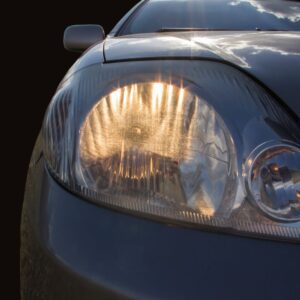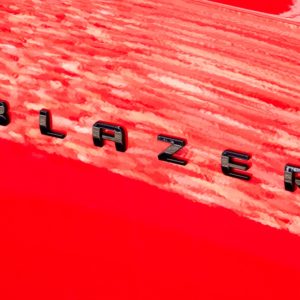Due to their sheer power, high-beam lights should be used with the following in mind:
- They must be used for highway driving at night.
- They should be dimmed when approaching other vehicles.
- They must be switched off in urban areas.
What Are High-Beam Headlights?
High-beam headlights are the strongest lights a vehicle can have, provided you don’t count aftermarket components explicitly designed to be stronger. These headlights are powerful enough to illuminate up to 400 feet ahead of the vehicle, giving drivers much-needed visibility when driving in darkness.
Because these lights play an important role in boosting visibility in low-light conditions, they are installed on every vehicle. They’re significantly more powerful than low-beam headlights.
However, just because they’re included in every vehicle doesn’t mean they should be activated all the time. There’s a time and a place for high-beam lights—using these lights improperly can blind other drivers on the road.
When Should High-Beam Lights Be Used?
High-beam lights come in handy when you’re driving in total darkness. They’re especially helpful when you’re alone and far from other vehicles. This means you should activate your high beams whenever you drive on long and lonely stretches like highways and country roads.

When Should You Avoid Using High-Beam Lights?
While high-beam lights are useful thanks to their powerful illumination, using them can hamper the vision of other drivers. This is why it’s important to dim your high-beam lights when driving near other vehicles. Similarly, they should be switched off entirely whenever you drive in urban areas like towns and cities.
High beams should also be switched off when you drive in conditions with low visibility like when it’s foggy, raining, or snowing. This is because the particles in the air scatter the light, making it more difficult to see whatever’s in front of you.
High-Beam Laws For All 50 States
The laws concerning the use of high beams differ from state to state. If you want to familiarize yourself with the different high-beam laws according to the states, read on.
Alabama
You must dim your high beam lights when within:
- 500 feet of traffic
- 200 feet of another vehicle
Alaska
You must dim your high beam lights when within:
- 500 feet of traffic
- 300 feet of another vehicle
Arizona
You must dim your high beam lights when within:
- 500 feet of traffic
- 200 feet of another vehicle
The use of high-beam lights in foggy weather is also prohibited.
Arkansas
You must dim your high beam lights when within:
- 500 feet of traffic
- 200 feet of another vehicle
The use of high-beam lights in rain, snow, and fog is also prohibited.
California
You must dim your high beam lights when within:
- 500 feet of traffic
Colorado
You must dim your high beam lights when within:
- 500 feet of traffic
- 200 feet of another vehicle
The use of high-beam lights in fog is prohibited. However, fog lights are allowed.
Connecticut
You must dim your high beam lights when within:
- 500 feet of traffic
- 300 feet of another vehicle
Delaware
You must dim your high beam lights when within:
- 500 feet of traffic
- 200 feet of another vehicle
Florida
You must dim your high beam lights when within:
- 500 feet of traffic
- 300 feet of another vehicle
High beam lights also cannot be used with street lights, and they are to be used in open country.
Georgia
You must dim your high beam lights when within:
- 500 feet of traffic
- 200 feet of another vehicle
The use of high-beam lights in lighted roads, rain, snow, fog, and smoke is also prohibited. In addition, high-beam lights can only be used in rural areas.
Hawaii
You must dim your high beam lights when:
- Meeting with traffic
Idaho
You must dim your high beam lights when within:
- 500 feet of traffic
- 200 feet of another vehicle
Illinois
You must dim your high beam lights when within:
- 500 feet of traffic
- 300 feet of another vehicle
Indiana
You must dim your high beam lights when within:
- 500 feet of traffic
- 200 feet of another vehicle
Iowa
You must dim your high beam lights when within:
- 1000 feet of traffic
- 400 feet of another vehicle
Kansas
You must dim your high beam lights when:
- Other vehicles approach you
- You are driving in fog
Kentucky
You must dim your high beam lights when within:
- 500 feet of traffic
- 200 feet of another vehicle
Your high beams must be strong enough to make people within 350 in front of you completely visible.
Louisiana
You must dim your high beam lights when within:
- 500 feet of traffic
Maine
You must dim your high beam lights when within:
- 500 feet of traffic
- 300 feet of another vehicle
Maryland
You must dim your high beam lights when within:
- 500 feet of traffic
- 300 feet of another vehicle
Massachusetts
You must dim your high beam lights when within:
- 500 feet of traffic
- 200 feet of another vehicle
Michigan
You must dim your high beam lights when within:
- 1000 feet of traffic
- 200 feet of another vehicle
Minnesota
You must dim your high beam lights when:
- You are driving behind a commercial vehicle after sundown
- You are within 1000 feet of traffic
- You are within 200 feet of another vehicle
High beams should be used as frequently as possible. However, you cannot leave your high beams on after parking your car.
Mississippi
You must dim your high beam lights when within:
- 500 feet of traffic
Missouri
You must dim your high beam lights when within:
- 500 feet of traffic
- 300 feet of another vehicle

Montana
You must dim your high beam lights when within:
- 1000 feet of traffic
- 500 feet of another vehicle
Nebraska
You must dim your high beam lights when within:
- 200 feet of another vehicle
High beams must also be dimmed when you approach oncoming traffic.
Nevada
You must dim your high beam lights when within:
- 500 feet of traffic
- 300 feet of another vehicle
New Hampshire
You must dim your high beam lights when within:
- 150 feet of another vehicle
New Jersey
Whenever you approach vehicles, either from the front or behind, you must dim your high beams.
New Mexico
You must dim your high beam lights when within:
- 500 feet of traffic
- 200 feet of another vehicle
New York
You must dim your high beam lights when within:
- 500 feet of traffic
- 200 feet of another vehicle
You must also dim your high beams when pedestrians are near your vehicle.
North Carolina
You must dim your high beam lights when within:
- 500 feet of traffic
North Dakota
You must dim your high beam lights when within:
- 500 feet of traffic
- 300 feet of another vehicle
Ohio
High beams must be dimmed whenever you approach other vehicles.
Oklahoma
You must dim your high beam lights when within:
- 1000 feet of traffic
- 600 feet of another vehicle
Oregon
You must dim your high beam lights when within:
- 500 feet of traffic
- 350 feet of another vehicle
Pennsylvania
You must dim your high beam lights when within:
- 500 feet of traffic
- 300 feet of another vehicle
Rhode Island
You must dim your high beam lights when within:
- 500 feet of traffic
- 200 feet of another vehicle
The use of high beams is prohibited in all driving conditions with low visibility such as rain, fog, or snow.
South Carolina
You must dim your high beam lights when within:
- 500 feet of traffic
- 200 feet of another vehicle
South Dakota
High beams must be dimmed whenever you overtake a vehicle from behind or from the front.
Tennessee
You must dim your high beam lights when within:
- 500 feet of traffic
- 500 feet of another vehicle
Texas
You must dim your high beam lights when within:
- 500 feet of traffic
- 300 feet of another vehicle
The use of high beams is prohibited when driving in fog, rain, sleet, dust, or rain. In addition, they cannot be used whenever you drive on lighted roads.
Utah
You must dim your high beam lights when within:
- 500 feet of traffic
- 300 feet of another vehicle
Vermont
Drivers must dim their high beams when approaching other vehicles. They must also be turned off when driving on roads with street lights, or when following another vehicle. In addition, their use is prohibited in foggy conditions.
Virginia
You must dim your high beam lights when within:
- 500 feet of traffic
- 200 feet of another vehicle
High beams should also not be used when driving in urban areas like towns and cities unless no other lighting is available.
Washington
You must dim your high beam lights when within:
- 500 feet of traffic
- 300 feet of another vehicle
The use of high beams is prohibited in fog, snow, or rain.
West Virginia
You must dim your high beam lights when within:
- 500 feet of traffic
- 200 feet of another vehicle
The use of high beams is prohibited in urban areas like cities and towns unless no other lighting is available.
Wisconsin
You must dim your high beam lights when within:
- 500 feet of traffic
- 500 feet of another vehicle
High beams cannot be used when driving in conditions with low visibility like fog, rain, or snow.
Wyoming
You must dim your high beam lights when within:
- 500 feet of traffic
- 300 feet of another vehicle
The use of high-beam lights when driving on rural highways is encouraged.
Any information provided on this Website is for informational purposes only and is not intended to replace consultation with a professional mechanic. The accuracy and timeliness of the information may change from the time of publication.


















